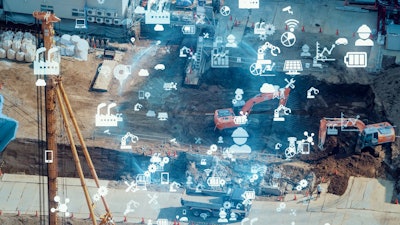
As there are many moving parts on a given construction site, there are also many contractors serving distinct roles with various responsibilities. Particularly, a general contractor needs to know and keep track of a variety of details throughout the length of the project such as acquiring building permits, site surveying, managing personnel and subcontractors, and waste management.
When planning for these and other to-do list items, a seasoned contractor can move forward understanding what will likely happen next based on past experiences. Of course, there are many situations that are unpredictable, where even the most experienced professional can only guess what will happen, as he doesn't have access to all the hidden information across the project. This is increasingly becoming known as the digital "dark data" that can be found in almost every function during building production.
So, what is this "dark data"? Gartner defines dark data as the information assets organizations collect, process and store during regular business activities, but generally fail to use for other purposes. It’s estimated that companies only use or tap into about 1% of the dark data that they have and store. In construction, the problem with dark data is that the industry doesn’t access, much less realize its value. According to a white paper from FMI, 95% of all data captured in the construction and engineering industry goes unused.
It is easy to understand why data can become dark, but how can seeing it make a difference for a contractor?
Contractor obstacles and scenarios
Though there are many things a general contractor needs to juggle, there are some common ones that all of them face, regardless of the particulars of a construction site. Typically this might include:
- Keeping the schedule up to date: With the many initiatives happening at any given time for a construction site, it usually equals a lot of updates as well. And if all the connected parties at a site are updating a contractor in various ways (email, in-person, text, etc.), it can be easy for changes to the program to be missed, with the schedule being out-of-date nearly all the time. This is like trying to navigate new roads with an old map.
- Task delegation: When there is a large staff of subcontractors and personnel to keep track of, it can be easy to lose track of what tasks have been delegated and what the progress is on various goals. In fact, a project manager might spend a lot of their day reviewing multiple forms or software tools, just trying to figure out what has been completed.
- Keeping track of all of the notes: This is still an industry that loves to put its notes on paper and there are examples where notes and daily logs can lead to a ton of useful data, including past risk avoidance tactics/results, installation success/failures, and learned best practices for tackling specific weather/delivery/lifting/storage situations. The industry has become much better at using software to capture all of this, but multiple disconnected silos of digital information are tough to refer to, becoming impractical to use in any meaningful way.
Access to this dark data can make a world of difference in both managing the flow of information and using it to determine what the next steps should be for various site initiatives. Imagine a scenario where a contractor has access to modern tools, such as AI and machine learning, and is able to use these tools to access dark data and then apply it to other real time data, such as traffic and weather. It might work out like this scenario:
Building A is being built, the schedule is approved, and the land is leveled and ready to go. The process of pouring the concrete for the first platform level is in the schedule and has a start date. The construction team can use AI to track and predict weather and traffic patterns around the site, so it is then possible to coordinate all the people, equipment and resources so that they are ready for anything on the day of the pour.
But, what if that day, the weather forecast had expected rain, but the hyper local weather conditions are real-time, reporting temperature moving to a little above freezing during the time which the pour is supposed to happen? AI accessing relevant data can be used to alert the team that it’s unlikely that the concrete can be poured effectively because of changing conditions - automatic notifications are sent to trucks and the concrete supplier, plus the work teams are redeployed to other tasks that are not so weather sensitive. All without relying on one person having to check all the different data sources, all the time.
In this scenario, AI tools access all of the relevant data and in real-time, processes it in a way that alleviates common contractor headaches all at once. The result is that the team doesn’t waste time, money, and resources trying to pour concrete on days when the weather, traffic, equipment, or labor availability won’t make it suitable to do so.
In conclusion, this dark data is not so dark, as it is mostly based on information already being recorded daily by numerous members of any given contractor or sub-contractor team. The good news is that the industry is catching up to a new wave of AI-based tools being used to harness this data and apply it to the decision-making process. This means that in the near future, there will be more and more scenarios where contractors will be able to manage the flow of information, tasks and personnel updates in a way that maximizes efficiency and provides them with less headaches.
Richard Harpham is the CRO of Slate Technologies, an AI platform that maximizes efficiency and costs for the construction industry. Prior to Slate, he led the software commercialization efforts for construction startup Katerra, which was a technology-driven off-site construction company.














